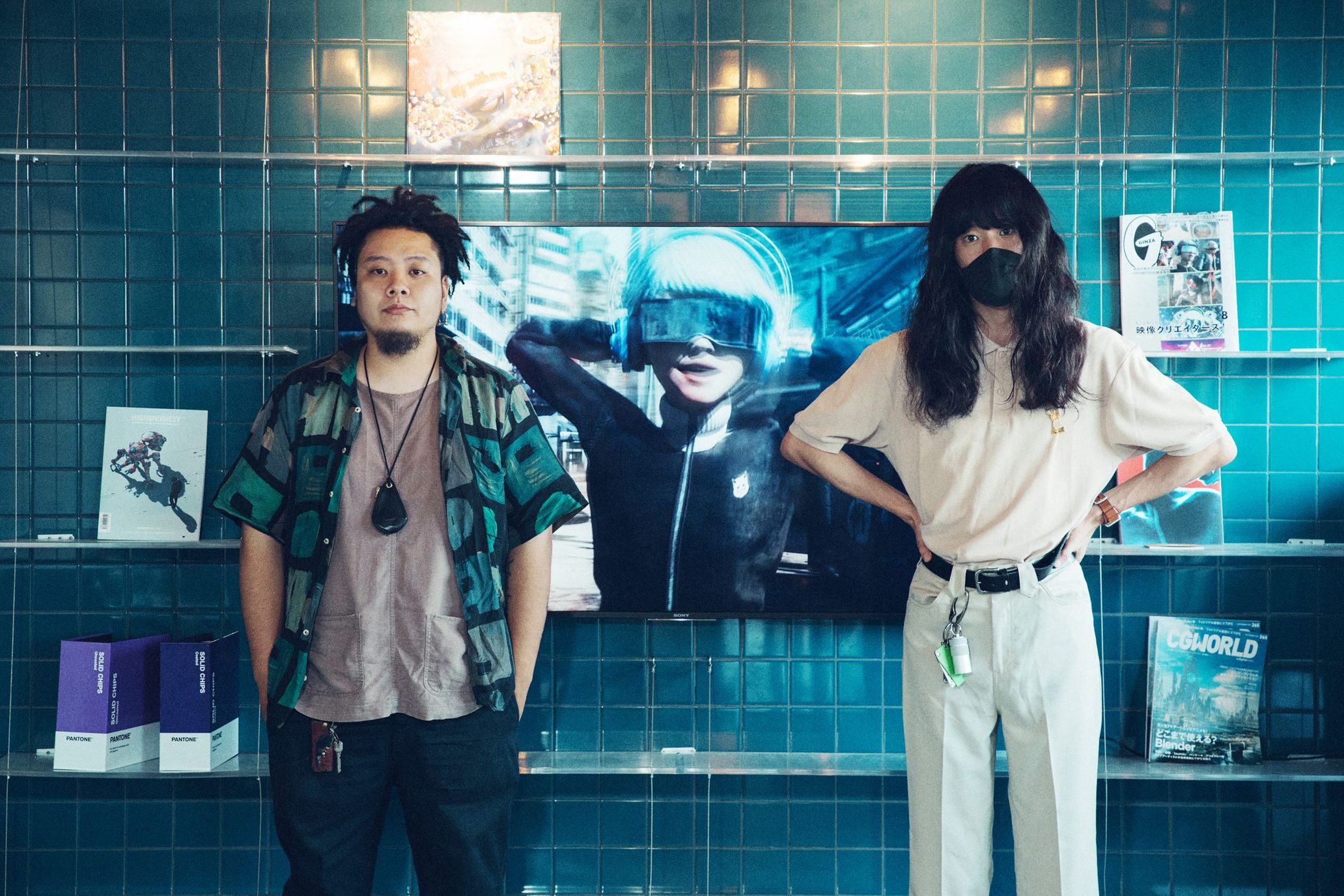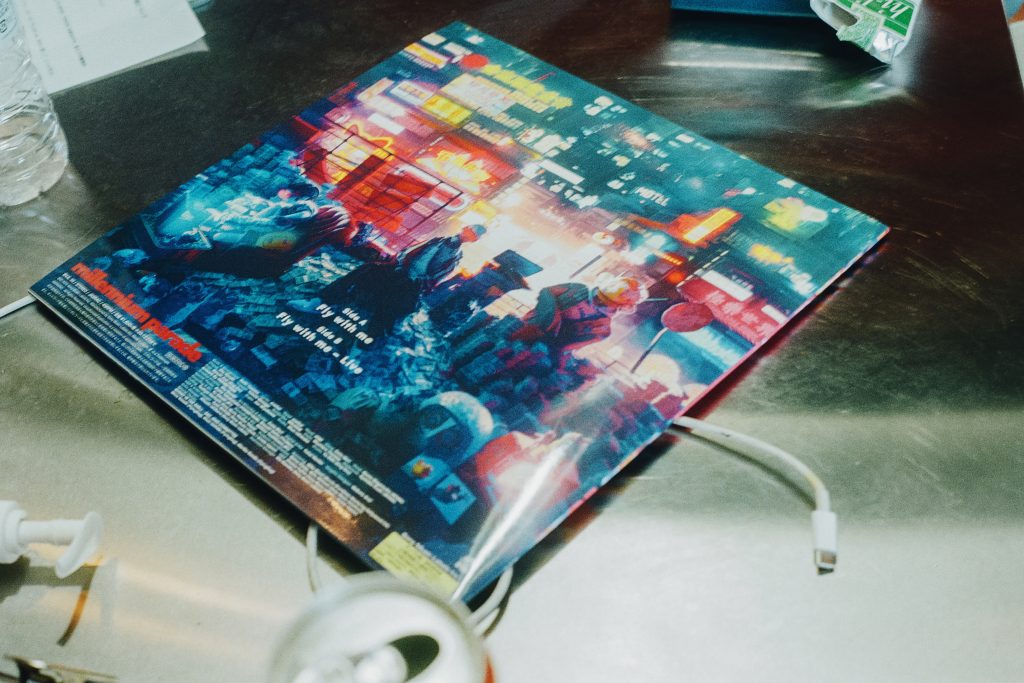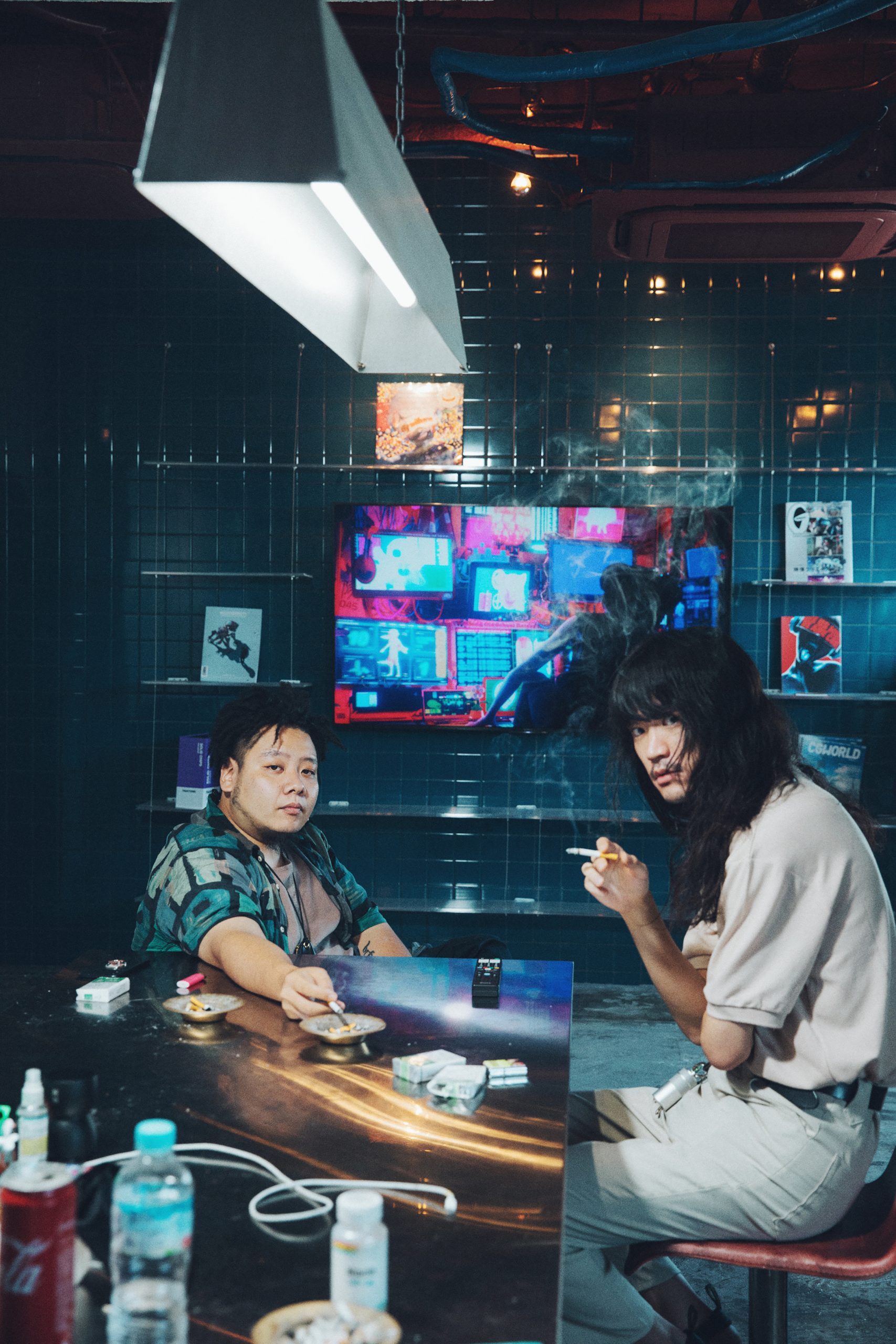“Fly with me” is the theme song for the Netflix animation series, Ghost in the Shell: SAC_2045. The CG-animated music video depicts an Asian setting with a storyline that unfolds like a film. When the teaser for the song -a bitmap video reminiscent of games- was released, it took everyone by surprise. PERIMETRON is a creative collective run by Daiki Tsuneta (King Gnu/millennium parade), and they led the team for the music video. There has always been a wealth of films and other mediums that portray Asia in a cyberpunk-ish fashion. What does a Japanese interpretation of that look like? The music video for “Fly with me” could be the answer. We asked Shu Sasaki and Yuhei Kanbe, core members of PERIMETRON and directors of the music video, about the universe they created together.
Imagining what 2045 could look like
――I’m constantly amazed by a lot of different factors in millennium parade’s music videos; technique, plot, mode of expression, and so on. Since the release of the “Fly with me” music video in April, it has shocked the globe and become a topic of discussion. I pictured the words “a futuristic Asianness” in my head when I saw it. I would like to hear about how you view the universe you made as creators of the music video.
Shu Sasaki (hereinafter Shu): Visually speaking, what you said is spot on because we actually collected references that had this futuristic, Asian feel to them. The East Asian vibe was the central theme. We thought about what sort of cities might exist in the future as we created the music video. As a team, we talked about how some aspects of the future might be more lucid and logical, while other aspects might not look different from the present.
Yuhei Kanbe (hereinafter Yuhei): As the title suggests, Ghost in the Shell: SAC_2045 is set in the year 2045, so we tried to come up with something that matched that. The series shows a much more technologically advanced world, whereas the setting in the music video is a lot closer to the modern age. Part of the reason comes from our preferences and tastes. Another reason is that we don’t really have these grand hopes and dreams for 2045. Even regarding the progress of technology, we came up with something that was perhaps a bit more plausible.
Shu: Singularity is a topic on everyone’s lips right now and this phenomenon does occur here and there, yeah? It’s hard to imagine a future that is as advanced as Ghost in the Shell: SAC_2045, but with “Fly with me,” we attempted to depict a future that might be in the realm of possibility.
Yuhei: Yes, it is set in the future, but some things are reminiscent of today’s society. One thing that stands out is the traffic sign that appears when the three characters walk on the road. At the time of making, we did think about drawing a hologram to give it a Sci-fi touch but, it didn’t feel right. That is why we drew a traffic sign that looks like the ones we have today.
Shu: Oh yeah, that’s right! I think What Yuhei said speaks to our preferences. It was a conscious choice to portray a world inside of a game, so the functional, technological parts are highly advanced while the human parts aren’t that different from the present.
――Having that level of quality and complete worldmaking in a music video is unheard of in Japan.
Shu: We weren’t like “here’s something you’ve never seen before!” when we were creating this. We just kept on asking ourselves how we could make something good.
Yuhei: Honestly, we were able to come up with this due to everyone’s efforts.
Shu: Yeah. It was like we were playing baseball as a team. We had each other’s backs; we were like, “I’m leaving this part up to you! I trust you.” We kept on passing the ball from one person to the other.
Yuhei: Yep. That really worked out for us on “Fly with me.” Each person had the proper skills and we all related to one another during the process.
Shu: There were a lot of people that stayed with us until the very end, even if it was just talking about the project. We all thought about how we could make the process fun and interesting, and each person would try stuff out. We all progressed in a way that made everyone happy. Doing the same thing over and over meant getting more additional work, but no one complained. We watched each other’s cuts and pitched in ideas. That was how it flowed. Compared to other projects, we had so many people willing to take chances head-on and that was huge for me.
The essence of “futuristic” and “Asian” could be seen in PERIMETRON’s previous works as well.
Nostalgic, not futuristic
――Depending on how you see it, some scenes look similar to films like Bladerunner and The Matrix. What sort of references did you pull from?
Shu: You know those futuristic, cyberpunk cities that are in those kinds of films? They use bright colors like cyan and magenta, and we didn’t use those colors. When we garner references, there are cases where we share images or videos that could work. Other times, we share materials that show what we are not going to do. We collected references from the latter. By doing so, we were able to move forward with a limit on what we could and couldn’t do.
――I see. I assumed that you tried to emulate a cyberpunk setting.
Yuhei: The video does have a cyberpunk essence, so perhaps you could feel that way by viewing this from a broader perspective. But recent interpretations of cyberpunk have these weird Japanese-ish writings on neon signs and all. We think that stereotype is passe. That’s why we drew the line and made this in a sort of antithetical manner. Our preferences and likes are reflected in those details.
Shu: Yeah. If a person that doesn’t like cyberpunk watches the music video, they might think it looks just like cyberpunk, but the differences are in the small details. In that sense, “Fly with me” has a meticulous finish to it.
Yuhei: With that being said, of course, some aspects are an homage to Bladerunner. There’s a sign with the words “millennium parade” written in katakana on the back cover of the “Fly with me” album. And that might be an homage. We’re not against classic cyberpunk art forms; we’re against recent, mainstream cyberpunk.
Shu: For instance, in Lil Dicky’s “Earth” music video, he goes around the globe and in one scene Asia pops up as he says “Hey Asia.” Sure enough, this version of Asia is a high-tech city at night filled with neon. This is just one example, but a part of me felt like, “so this is what the world pictures when they think of Asia.” However, creators have the ability to cut out that sort of cyberpunk impression upon portraying Asia. We did have an antithetical stance when we omitted those stereotypes.
――I’m sure your preferences are clearly reflected in “Fly with me,” but could you expand on what it is you’re particular about?
Yuhei: I dislike it when people illustrate the future as extreme. We didn’t make the music video by imagining what the future would look like. It was actually more like creating nostalgic scenes. When I was small, I would go to my grandmother’s place in the countryside and stare at the neon signs, the bright lights of Pachinko (a Japanese gambling machine) shops, and lights that were on the verge of dying. Bands like Moonriders and The Beatles would play in my father’s car as I looked outside. Cyberpunk is commonly understood as an electronically and technologically advanced genre, but personally, it’s more nostalgic. It harkens back to past experiences.
Shu: Maybe you like things that are in your blood.
Yuhei: True. Maybe it makes me feel good when I’m immersed in my memories (laughs).
Bringing back the childhood memories of Wa
――Shu, what are your influences when it comes to your work?
Shu: To put it generally- culture-specific to Japan. My father used to deal with old works of Japanese art, so there were a lot of traditional artworks in my environment as a child. I often find myself thinking about the essence of Wa (a Japanese concept meaning “harmony”) and Shinto. Those elements are incorporated into the concepts behind my videos and art. However, when I’m in the midst of creating something, I think I tend to turn to the things I’m into at the time or things I want to explore more deeply. I want to work honestly. Like “I chose this material because it’s what I’m into right now.” You know, it’s boring if my videos pose to be something without any substance.
Yuhei: I can relate to that. If you make something “just because,” then you can’t explain your work clearly when someone asks you about it. I think you would have to be like, “uh, I guess I did it because it’s trendy.”
Shu: Exactly. You can say something that seems impressive on the surface, but I feel like that you wouldn’t be able to go any further than that. Daiki [Tsuneta] and I talk about this a lot, but I want to “chew” on my work and really taste it until it gets digested properly. Whatever comes out of that process could be called art. That is my belief. Otherwise, your creation will be bland. When you work as a producer like me, there are times where you have to operate in a field that’s hard to define. I have begun to think this way only recently. Even if I’m working on two different projects simultaneously, at the end of the day, the person doing those projects is the same- me. I want all of my works to have the same source of thought. Compared to before, I feel like I’ve stopped trying to change my mode of expression from project to project. On top of focusing on where I could incorporate my feelings and the vision I aim for, I’ve started to think about how I could do that.
Yuhei: I guess you can say that you’ve developed a backbone.
Shu: Maybe.
――Yuhei, can you relate to Shu’s philosophy regarding the process of creating something?
Yuhei: Personally, I don’t take the “trial and error” path upon directing the main storyline or universe of a certain video. I approach it from a technical perspective. I think Shu and I are different in that aspect. I think about how I could manifest something with technology. Another thing I do is look for better modes of expression if necessary. However, I do practice the whole “digest your work properly before putting it out there” thing Shu talked about.
――I see. Both of you were directors of “Fly with me.” Could you talk about the relationship you have with each other?
Yuhei: Shu is like a father figure to me. His role was originally similar to that of a producer at PERIMETRON, and so there were so many things that just didn’t work without his help. Aside from producing, he also directs and designs; I can’t keep track of all the things he does. But ultimately, Shu gets the job done. I can rely on him outside of work too. So yeah, he really is like a father (laughs).
Shu: Yuhei is like the best software extension. Even if I explain a creative brief very vaguely, he comprehends it properly and comes back with something that exceeds my expectations. It’s a delight watching him to that. He was my co-director for “Fly with me” and I do not doubt that we opened another door with our work. I feel like he’s upgraded to a software extension with AI capabilities. I think he’s especially improved over the past year.
――Our current society feels quite insular because of the coronavirus pandemic, but has it affected your creativity?
Shu: The whole world hasn’t had a vibe this negative at the same time before. That’s why we want to refrain from creating negative things. We don’t want to come up with something that criticizes only one aspect of an issue. It’s probably just how I view things. Let’s say that I created something with a negative message. I think the delivery would come off as premature. Of course, I want to raise questions and get the audience to think, but at the moment, I want to do something that could cheer people up. I think about this way more now.
PERIMETRON
PERIMETRON is a creative team led by King Gnu and millennium parade frontman, Daiki Tsuneta. The team has created visuals for King Gnu and millennium parade as well as Tempalay and WONK. On top of this, they have provided visuals for brands; as such, they work across all fields. The music video for “Fly with me,” which is the theme song for the Netflix animation series called Ghost in the Shell: SAC_2045, has gained over 6 million views and is the topic of discussion globally.
https://www.perimetron.jp/
Instagram:@perimetron
https://www.youtube.com/user/mrsvincichannel
Photography Takaki Iwata
Translation Lena-Grace Suda






